|
|
|
|
|
Freshwater Fishing 101
|
|
|
|
Fishing Habitats
|
|
|
 The
St. John's River is the longest river in
Florida at 310 miles, and one of the few
north flowing rivers in the US. From the
headwaters in the South to its mouth at
Jacksonville in Northeast Florida there is
only a 30 foot change in elevation and the
river flows at a lazy 1/3 of a mile per
hour. The St. Johns here is a Blackwater
stream, meaning that its primary water
supply is fed primarily by the swamps and
wetlands that surround it and groundwater
seeping up through the sandy soil prevalent
in the area, with no major tributaries. Well
to the north of the Space Coast Area, the
river is as much as three miles wide,
supports shipping and is more developed
along its shores. However, we are located
within what is called the Upper (Southern)
Basin of the river and for the 75 miles that
the St. Johns flows through this basin it is
narrow, shallow, 3-8 feet, surrounded by
wetlands and floodplain, and has many side
channels or backwaters, is suited for small
boats and airboats only and can be confusing
to navigate because it can be hard to
discern the main course from the backwaters,
especially the section west of Titusville
between State Road 50 and State Road 46.
Shoreline development is minimal and for the
most part the view from a boat is much the
same as it was 100 years ago. The headwaters
begin in the un-navigable swamps surrounding
Lake Blue Cyprus in North Indian River
County. The river becomes navigable to small
craft in southern Brevard County west of the
city of Palm Bay, starting just south of
Lake Hell 'n Blazes, sometimes spelled
Hellen Blazes to satisfy the tender hearted.
If you travel North on the river from Lake
Hell 'n Blazes you will pass through several
notable lakes before you get to the
northernmost lake in our coverage area, Lake
Harney. They are Hell 'n Blazes (381 acres),
Little Sawgrass (100 acres max), Sawgrass
(maybe 400 acres), Washington (4,300 acres),
Winder (1500 acres), Poinsett (4,300 acres),
Puzzle (1300 acres), and then Lake Harney (9
sq. miles). Loughman Lake, and Salt Lake are
connected by Six Mile Creek west of
Titusville. None of these lakes have any
real depth to them. Washington may have
depths of about 10 feet in some places but
the average is more in the 3-6 foot range.
Other tributaries in the upper basin include
Taylor Creek near Lake Poinsett and the
Econlokhatchee River just south of the
bridge at State Road 46. The
St. John's River is the longest river in
Florida at 310 miles, and one of the few
north flowing rivers in the US. From the
headwaters in the South to its mouth at
Jacksonville in Northeast Florida there is
only a 30 foot change in elevation and the
river flows at a lazy 1/3 of a mile per
hour. The St. Johns here is a Blackwater
stream, meaning that its primary water
supply is fed primarily by the swamps and
wetlands that surround it and groundwater
seeping up through the sandy soil prevalent
in the area, with no major tributaries. Well
to the north of the Space Coast Area, the
river is as much as three miles wide,
supports shipping and is more developed
along its shores. However, we are located
within what is called the Upper (Southern)
Basin of the river and for the 75 miles that
the St. Johns flows through this basin it is
narrow, shallow, 3-8 feet, surrounded by
wetlands and floodplain, and has many side
channels or backwaters, is suited for small
boats and airboats only and can be confusing
to navigate because it can be hard to
discern the main course from the backwaters,
especially the section west of Titusville
between State Road 50 and State Road 46.
Shoreline development is minimal and for the
most part the view from a boat is much the
same as it was 100 years ago. The headwaters
begin in the un-navigable swamps surrounding
Lake Blue Cyprus in North Indian River
County. The river becomes navigable to small
craft in southern Brevard County west of the
city of Palm Bay, starting just south of
Lake Hell 'n Blazes, sometimes spelled
Hellen Blazes to satisfy the tender hearted.
If you travel North on the river from Lake
Hell 'n Blazes you will pass through several
notable lakes before you get to the
northernmost lake in our coverage area, Lake
Harney. They are Hell 'n Blazes (381 acres),
Little Sawgrass (100 acres max), Sawgrass
(maybe 400 acres), Washington (4,300 acres),
Winder (1500 acres), Poinsett (4,300 acres),
Puzzle (1300 acres), and then Lake Harney (9
sq. miles). Loughman Lake, and Salt Lake are
connected by Six Mile Creek west of
Titusville. None of these lakes have any
real depth to them. Washington may have
depths of about 10 feet in some places but
the average is more in the 3-6 foot range.
Other tributaries in the upper basin include
Taylor Creek near Lake Poinsett and the
Econlokhatchee River just south of the
bridge at State Road 46.
In spite of the fact that Brevard County is
over 70 miles in length, (top to bottom) and
the St. Johns runs virtually along the
entire length, forming the western border,
easy public access to the river, especially
for shore-bound anglers is limited. The
river and its lakes are for the most part
protected from shoreline development by the
wetlands that surround it There are only 5
roads that actually cross the river's upper
basin and they include State Road 192, in
Melbourne, State Road 520 from South Cocoa,
SR 528 between Cocoa and Titusville, State
Road 50 from Titusville, and State Road 46
from Mims. All but State Road 528 have
facilities for launching a boat into the
river and shoreline fishing. There are a few
other shoreline fishing locations where you
can fish from shore, launch a canoe or kayak
or a boat, some run by the Brevard County
Parks and Recreation Department as well as a
privately owned fish camp or two that allow
shoreline fishing on their properties. These
will be covered in greater depth on the
Freshwater Locations. |
|
Other Freshwater Opportunities
|
| While the St. John's River and its lakes
are the primary freshwater fishing locations
along the Space Coast they are by no means
the only places to fish freshwater.
Throughout the Space Coast, Freshwater
opportunities can be found in various easy
to drive to lakes, natural ponds, retention
ponds, barrow pits, and even some drainage
canals. For the shoreline angler as well as
those fishing from canoes or kayaks, these
can often be better opportunities than the
St. John's. In addition to the lack of dry
shoreline access the St. John's has many
tight twists and turns. While most motor
boaters and air-boaters are conscientious
about safety, Traffic can be heavy at times.
Other opportunities exist for anglers
willing to do a bit of hiking or off road
biking well of the beaten path, providing
wilderness solitude as well as a chance to
fish seldom visited waters. All of these
will be discussed on the Freshwater
Locations Page. |
|
Fishing Rivers and Streams
|
To get the best results from a fishing
trip, it is important to understand and be
able to visualize what is beneath the
surface of the water. Fish don't just hang
out anywhere in a body of water. They have
preferences in water depth, current
strength, and most of all like to be near
some sort of cover. Therefore while just
randomly casting into water may get you an
occasional fish, paying attention to your
surroundings and knowing what particular
fish prefer can make all the difference in
the world.
Rarely does a river flow in a straight line.
The St. John's has many twists and turns and
these bends in the river can provide some
good places to check out. Let's say you come
to a bend in the river and the turn is to
your left. The water closer to the shore on
the right side, or outside of the bend will
usually be deeper water. The current flushes
out bottom sediment and can carve a bowl or
hole in the bottom and erodes the outside
shoreline away, sometimes creating an
undercut bank. There may also be some
submerged structure near the outside shore
if the current has managed to uproot a
shoreline tree. On the other hand, sediment
being washed downstream will often collect
on the left or inside of the bend and form a
shallow sand or mud bar, which will
typically get shallower as time goes on.
Now if that same bar that has emergent
vegetation such as grasses or lily pads
growing from it, even though it may be
shallower than the rest of the river at that
point it may be a good place to try casting
a weedless lure for largemouth bass that may
be hiding among the vegetation waiting for
bait to be swept by with the current. If
drifting the river and you come across a
fallen tree or other structure along the
shoreline, be sure to try the area just
downstream of the structure as fish will
often hang out where the current has been
broken by the structure waiting in ambush
mode.
Docks, bridge pilings, and other manmade
structures can provide the same action. Also
look for areas where lily pads, grasses,
reeds, and other vegetation is growing from
the bottom sediment to at least the water's
surface or above. Again this has the effect
of slowing a current in the immediate
vicinity and providing hunting and ambush
cover. Overhanging bushes and trees are
great places to target bass bluegills, and
other sunfish, especially if you have a few
feet of water depth under the outer edge of
the branches as insects falling from the
tree provides and easy meal. |
|
Fishing Ponds and Lakes
|
| In a lake or pond, many of the same
structures that attract fish in the river
will also attract them in a lake, with the
exception that on a pond or lake, you don't
have to pay attention to which is the
upstream side or downstream side of the
structure. Shoreline vegetation, emergent
vegetation, submerged rocks, stumps, stands
of cyprus trees in the water, docks,
overhanging trees and bushes, and other
structure such as logs, brushpiles, and
rocks in deeper water can all be great fish
attractors. Another thing to look for are
clues to the underwater topography of the
pond or lake. Where a point of land sticks
out from the main shoreline there is a
better than average chance that elevation
difference extends into the lake, creating a
bar or ridge underwater. When a stream or
river enters the lake, a deeper channel
carved by moving water likely continues into
the lake. Even with no shoreline type
structure nearby just the change of
elevation underwater can attract fish. |
|
|
|
|
|
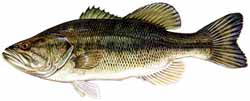 Largemouth
Bass; Common Names - black bass, Florida
bass, Florida (or southern) largemouth,
green bass, bigmouth, bucketmouth,
linesides, Oswego bass and green trout. Largemouth
Bass; Common Names - black bass, Florida
bass, Florida (or southern) largemouth,
green bass, bigmouth, bucketmouth,
linesides, Oswego bass and green trout.
Habitat - Prefers clear, nonflowing
waters with aquatic vegetation where food
and cover are available. They occupy
brackish to freshwater habitats, including
upper estuaries, rivers, lakes, reservoirs
and ponds. Also, they can tolerate a wide
range of water clarities and bottom types,
prefer water temperatures from 65 to 85
degrees, and are usually found at depths
less than 20 feet.
Spawning Habits - Spawning occurs
from December through May, but usually
begins in February and March in most of
Florida when water temperatures reach 58 to
65 degrees and continues as temperatures
rise into the 70s. The male builds
saucer-shaped nests 20 to 30 inches in
diameter by placing its lower jaw near the
bottom and rotating around this central
location. Bass prefer to build nests in
hard-bottom areas along shallow shorelines
or in protected areas such as canals and
coves.
Feeding Habits - The diet of bass
changes with its size. Young fish feed on
microscopic animals (zooplankton) and small
crustaceans such as grass shrimp and
crayfish. Fingerling bass feed on insects,
crayfish, and small fishes. Adult bass will
eat whatever is available, including fish,
crayfish, crabs, frogs, salamanders, snakes,
mice, turtles and even birds.
Sporting Qualities - The largemouth
bass is Florida's most popular freshwater
game fish. Much of its popularity is due to
its aggressive attitude and willingness to
strike a lure or bait with explosive force.
They will strike almost any kind of
artificial lure or live bait, but most are
taken on plastic worms, surface plugs,
spinnerbaits, crankbaits, bass bugs and
shiner minnows.
The value of the largemouth as a sport fish
has prompted a movement toward
catch-and-release fishing. As a sport fish,
specific bag and size limit regulations
apply, and you can register a qualifying
catch as part of the Florida Fish and
Wildlife Conservation Commission's "Big
Catch" program. Black bass are the most
popular sportfish in north America and their
value to Florida is immense
Eating Quality - The meat is white, flaky
and low in oil content. The flavor depends
upon the way the fish are cleaned and
prepared. The strong weedy taste of bass
caught in some waters may be eliminated by
skinning the fish and salting and peppering
the fillets before battering. Fillets
usually are fried, while larger ones may be
baked.
World Record - 22
pounds, 4 ounces, caught in Montgomery Lake,
Georgia in 1932.
Certified State Record
- 17 pounds, 4-1/4 ounces, caught in an
unnamed lake in Polk County in 1986. (Please
check link for updates)
Uncertified State
Record - 20 pounds, 2 ounces, caught in Big
Fish Lake (private pond) in Pasco County in
1923.
Largemouth Bass are
homebodies, meaning they will never stray
very far from where they are born. And they
will never be far from some type of
structure, whether it be an irregularity
along the bottom, shoreline vegetation, a
clump of submerged vegetation, fallen tree
in the water, lily pads, boat docks, rocks,
etc. They love cover and will almost always
be found near it. They also do not like
bright sunlight, which is one reason they
stay in cover and the fishing is usually
best in early mornings and late evenings.
Younger bass will eat almost anything that
moves which will fit in their mouths, while
older and larger bass seem to prefer a high
protein diet of smaller fish and amphibians
such as salamanders. They will also go after
baby ducks, and the occasional newly hatched
alligator.
Fish weedless worm rigs and other weedless
lures around any structure you find,
including all of the afore mentioned areas.
Don't miss any points of land you find. When
you see mats of duckweed or other floating
vegetation, drop an unweighted weedless worm
on top and twitch it across the surface of
the weeds. Don't be surprised to see a bass
explode through the weeds after the lure.
When working a shoreline that has grasses
growing in the water, and its calm out,
watch the grasses. Sometimes you will see
one grass stem twitch, creating little rings
of ripples in the water when none of the
other stems are moving. More times than not
this is an indication that a bass is in the
grass and has bumped against the stem. Work
this area with a weedless worm or other
weedless lure.
Cast Surface lures such as the Rapala
original floating minnow under overhanging
trees and branches, or along the edges of
emergent vegetation. Spinnerbaits can be
fished deep or shallow, or even buzzing the
surface. The overall point is, know that
bass like cover, and fish it. This is the
reason many bass fishermen swear by
baitcasting reels loaded with 17# or greater
line strength, as with a bit of practice,
they can be cast with pinpoint accuracy and
have the backbone to get a bass out and away
from cover before it has a chance to wrap
your line around some structure.
Size and possession limits apply.
Here's a couple of
great websites with lots of information on
Florida Bass Fishing;
http://www.floridabassfishing.us/
http://www.bassonline.com/
|
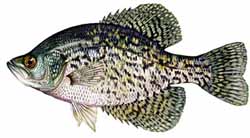 Black Crappie; Common Names - speckled
perch, specks, papermouth, bachelor perch,
calico bass, strawberry bass, or white
perch.
Black Crappie; Common Names - speckled
perch, specks, papermouth, bachelor perch,
calico bass, strawberry bass, or white
perch.
Habitat - Black crappies thrive in
clear, natural lakes and reservoirs with
moderate vegetation. They are also found in
large slow-moving less turbid rivers,
provided the water is not too murky.
Crappies prefer water from 70 to 75 degrees
but will tolerate water over 80 degrees. It
is gregarious and often travels in schools.
Spawning Habits - Spawning occurs
from February to April when water
temperatures reach 62 to 65 degrees. They
nest in colonies. Circular nest are fanned
by males over gravel or soft-muddy bottoms
and frequently around submerged vegetation
in waters from three to eight feet deep.
After spawning, males guard the eggs and
fry. Females may produce between 11,000 and
188,000 eggs.
Feeding Habits - Primary food items
are crustaceans, aquatic insects and small
fishes. Adults mainly eat small fish,
particularly open-water forage fish, like
threadfin shad.
Sporting Quality - Black crappies are
excellent game fish and are highly regarded
by bait fishermen and artificial-lure
anglers alike. They are easily caught during
prespawning periods when the fish are
congregated in large schools. Trolling with
small, live minnows or a spinner-fly
combination is very productive. They will
also strike subsurface flies, small
spinners, jigs, and tiny crankbaits.
Crappies tend to suspend in midwater, so you
may have to experiment to find the right
depth. As a sport fish,
specific bag and size limit regulations
apply, and you can register a
qualifying catch as part of the Florida Fish
and Wildlife Conservation Commission's "Big
Catch" program. |
 Bluegill;
Common Names - bream, blue bream, sun
perch, blue sunfish, copperhead,
copperbelly, roach. Bluegill;
Common Names - bream, blue bream, sun
perch, blue sunfish, copperhead,
copperbelly, roach.
Habitat - Bluegills prefer the quiet,
weedy waters where they can hide and feed.
They inhabit lakes and ponds, slow-flowing
rivers and streams with sand, mud, or gravel
bottoms, near aquatic vegetation.
Spawning Habits - Bluegills are well
known for "bedding" in large groups, with
their circular beds touching one another.
Bedding occurs in water two to six feet deep
over sand, shell or gravel, and often among
plant roots when the bottom is soft.
Spawning occurs from April through October
with the peak in May and June, when water
temperature rises to about 78-80 degrees. A
female may lay 2,000 to 63,000 eggs, which
hatch 30 to 35 hours after fertilization.
Feeding Habits - Insects, insect
larvae and crustaceans are the dominant
foods of bluegills, with vegetation, fish
eggs, small fish, mollusks, and snails being
of secondary importance, although they may
dominate their diet during certain times of
the year.
Sporting Qualities - Because of its
willingness to take a variety of natural
baits (e.g., crickets, grass shrimp, worms)
and artificial lures (e.g., small spinners
or popping bugs) during the entire year, its
gameness when hooked, and its excellent food
qualities, the bluegill is one of the more
important sport fish in Florida and the
eastern United States. As a sport fish,
specific bag and size limit regulations
apply, and you can register a
qualifying catch as part of the Florida Fish
and Wildlife Conservation Commission's "Big
Catch" program.
Eating Quality - Excellent; the flesh
is white, flaky, firm and sweet. They are
generally rolled in cornmeal or dipped in
pancake batter before frying. Many rank the
bluegill as the most delicious of all
freshwater fish.
|
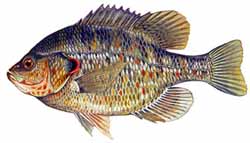 Redear
Sunfish; Common Names - Widely known as
shellcracker because of its fondness for
snails. Also called bream, yellow bream. Redear
Sunfish; Common Names - Widely known as
shellcracker because of its fondness for
snails. Also called bream, yellow bream.
Habitat - Redear are found in almost
every freshwater aquatic system in Florida.
They are typically found on sandy or
shell-covered areas of ponds and lakes, and
are often located near grasses. Redear spend
a great deal of time offshore in open water,
particularly in the winter. Other redear
found in rivers prefer, quiet waters and
have a tendency to congregate around stumps,
roots and logs. They are common in lower,
more slowly flowing reaches of rivers. They
tolerate brackish water better than other
sunfish. Like black bass and spotted
sunfish, they may be abundant in tidal areas
near the mouths of rivers.
Spawning Habits - Spawning occurs
during May, June and July (March through
August in central Florida) when water
temperatures reach 70 degrees. They prefer
water three to four feet deep, and a firm,
shelly bottom, often near a dropoff. Nesting
sites are often near aquatic vegetation such
as water lilies, cattails, lizardtails, and
maidencane. Breeding behavior is similar to
other sunfish, with the males doing the nest
building and guarding the young. A female
may lay between 15,000 to 30,000 eggs during
a spawn.
Feeding Habits - Redears are
opportunistic bottom feeders, foraging
mainly during daylight hours on a variety of
invertebrates. Important food items include
snails and clams which are crushed by
grinding teeth in the throat; larval
insects, fish eggs, small fish, and
crustaceans. In some areas snails may be
secondary to insects as a food preference.
Sporting Quality - Strong fighters,
but more difficult to catch than most other
sunfish. The redear does not readily take
artificial lures but is easily taken on
natural baits. Most fish are taken on cane
poles with small hooks, corks, and split
shot for weight. Favorite baits are worms,
crickets, grubs, and shrimp fished in the
spring and summer during the bedding season.
Later in the season they move to much deeper
water or into heavy cover, where they are
difficult to locate. As a sport fish,
specific bag and size limit regulations
apply, and you can register a
qualifying catch as part of the Florida Fish
and Wildlife Conservation Commission's "Big
Catch" program.
Eating Quality - Similar to that of
bluegill, with white, flaky, sweet-tasting
meat. Prepared the same as bluegill. |
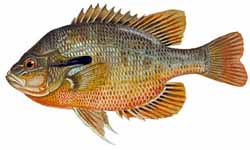 Redbreast
Sunfish; Common Names - redbelly, robin,
yellowbelly sunfish, bream, river bream,
longear sunfish, sun perch and redbreast
bream. Redbreast
Sunfish; Common Names - redbelly, robin,
yellowbelly sunfish, bream, river bream,
longear sunfish, sun perch and redbreast
bream.
Habitat - Redbreasts inhabit
sand-bottom areas as well as rocky areas of
coastal-plain streams, rivers, and lakes.
They frequently concentrate around boulders,
limestone outcroppings, logs, aquatic
vegetation, or in undercut tree roots.
Spawning Habits - They reproduce in
typical sunfish fashion by constructing
circular beds; but not clustered like
bluegills, in water from one to three feet
deep usually adjacent underwater objects
such as stumps and snags. They often occupy
beds that have been abandoned by other
sunfishes. Spawning occurs from May through
August when water temperatures range from 68
to 82 degrees. Males are the nest builders
and guard the eggs and larvae for a short
period after hatching. The number of eggs
laid in a season ranges from about 1,000 to
10,000, varying with the age and size of the
female.
Feeding Habits - The redbreast's diet
is probably the most varied of any of the
sunfishes. Principal food organisms are
bottom-dwelling insect larvae, snails,
clams, shrimp, crayfish, and small fish.
Sporting Qualities - Redbreasts are
prized game fish and are caught on natural
baits and artificial lures. They a good
fighters and will bite on flies and small
spinners, as well as worms, crickets,
grasshoppers and small minnows. Unlike most
sunfishes, redbreasts bite well at night.
Fishing from a drifting or slowly powered
boat is the best way to catch redbreasts,
although angling from the bank can be
productive. As a sport fish,
specific bag and size limit regulations
apply, and you can register a
qualifying catch as part of the Florida Fish
and Wildlife Conservation Commission's "Big
Catch" program.
Eating Quality - The sweet, flaky,
white flesh is excellent eating. They are
most often fried after dipping them in
seasoned cornmeal or pancake batter. |
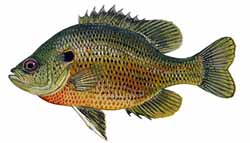 Spotted
Sunfish; Common Names - stumpknocker and
bream. Spotted
Sunfish; Common Names - stumpknocker and
bream.
Habitat - The preferred habitat is
slow-moving, heavily vegetated streams and
rivers with limestone, sand, or gravel
substrates. They are virtually ubiquitous
inhabiting large rivers to very small
creeks.
Spawning Habits - A nest-building
sunfish that tends to be more solitary than
some of the other members of the sunfish
family. Males are very aggressive and
antagonistic toward other fish in its
nesting area. The beds are about one foot in
diameter and are fanned out by the male, who
also stands guard over the eggs and larvae.
Concentrations of beds are found where
suitable habitat is limited. Spawning takes
place from May through November.
Feeding Habits - This species is very
aggressive and will take almost anything
they can attack and catch. They generally
feed on the bottom, but sometimes it will
rise to the surface to take food. Spotted
sunfish will feed on invertebrates, insects
and small fishes when they are easy to
catch. The bulk of their diet consist of a
variety of plants and animals that are
usually associated with aquatic vegetation,
brush, or rubble.
Sporting Qualities - Because of its
small size the spotted sunfish has limited
value to the angler, but it is an active and
fiesty panfish. The same methods of fishing
discussed for the redbreast sunfish apply
for the spotted sunfish. As a sport fish,
specific bag and size limit regulations
apply, and you can register a
qualifying catch as part of the Florida Fish
and Wildlife Conservation Commission's "Big
Catch" program.
Eating Quality - The flesh is
excellent. Preparation is the same as the
redbreast sunfish. |
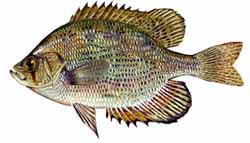 Flier
Sunfish; Common Names - round sunfish
and millpond flier. Flier
Sunfish; Common Names - round sunfish
and millpond flier.
Habitat - They inhabit dark, acidic
waters of coastal swamps, creeks, ponds, and
canals. They prefer heavily vegetated water
and are often found under mats of floating
vegetation. Fliers can tolerate waters too
acidic for other sunfish. They prefer water
temperatures from 75 to 85 degrees.
Spawning Habits - Spawning begins in
March when water temperatures reach 62 to 68
degrees. The male prepares a nest and the
female lays from 5,000 to 50,000 eggs.
Nesting may be solitary or in small
colonies. Males continuously guard the eggs
and recently hatched young.
Feeding Habits - Fliers are carnivorous
in their feeding habits. They prefer
insects, crustaceans, mollusks, worms,
leeches, and small fish are supplemented
with small quantities of phytoplankton.
Sporting Qualities - Although fliers
fight well for their size, they are often
too small to generate much interest among
anglers. Fliers can be caught on dry flies,
tiny poppers, worms, insect larvae and small
minnows. Good fishing locations are around
cypress trees and stumps, near brush piles,
and at the mouths of small creeks and
canals. As a sport fish,
specific bag and size limit regulations
apply, and you can register a
qualifying catch as part of the Florida Fish
and Wildlife Conservation Commission's "Big
Catch" program.
Eating Qualities - The flesh is sweet
and excellent to eat. The same methods of
cooking other sunfish apply for fliers. |
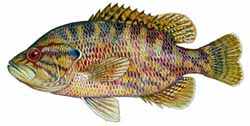 Warmouth;
Common Names - warmouth bass,
warmouth perch, goggle-eye, redeye and
goggle-eyed perch. Warmouth;
Common Names - warmouth bass,
warmouth perch, goggle-eye, redeye and
goggle-eyed perch.
Habitat - Warmouths inhabit swamps,
marshes, shallow lakes, slow-moving streams
and canals with soft, muddy bottoms. They
prefer to stay around aquatic vegetation,
stumps, and snags and under the banks of
streams and ponds. They have more tolerance
for muddy water than most species.
Spawning Habits - Warmouths are solitary
nesters that prefer to build their nest
adjacent to some submerged object. Nests are
found over a wide range of water depths.
They often spawn more than once a year
usually between April and August. Females
may produce 3,000 to 23,000 eggs.
Feeding Habits - Warmouths are
carnivorous. Crayfish, shrimp, insects and
small fishes make up the bulk of its diet.
Most of its feeding is done in the morning,
as it seems to sleep at night.
Sporting Qualities - The warmouth is one
of the more easily caught sunfish by anglers
using cane poles and natural baits, spinning
tackle with small topwater lures and
shallow-running spinners. They strike hard,
frequently breaking the surface of the
water. The best place to catch warmouths is
shallow water around trees, stumps, or
vegetation. As a sport fish,
specific bag and size limit regulations
apply, and you can register a
qualifying catch as part of the Florida Fish
and Wildlife Conservation Commission's "Big
Catch" program.
Eating Quality - The warmouth are
good to eat when caught from clean water.
Like other panfish they are relatively small
and bony. The flesh is usually prepared by
deep-frying after rolling it in seasoned
cornmeal. |
|
 Chain
Pickerel; Common Names - Pike, river
pike, grass pike, jack, jackfish, eastern
pickerel, chainsides, mud pickerel, black
chain pike, duck-billed pike. Chain
Pickerel; Common Names - Pike, river
pike, grass pike, jack, jackfish, eastern
pickerel, chainsides, mud pickerel, black
chain pike, duck-billed pike.
Habitat - Normally found in vegetated
lakes, swamps and backwaters, and small to
large rivers. They prefer water temperatures
from 75 to 80 degrees.
Spawning Habits - Chain pickerels are
random spawners rather than nest builders.
Spawning occurs in late winter to spring
among heavy aquatic weed growth or flooded
grasses, in water from a few inches deep to
several feet deep. Large number of adhesive
eggs are scattered over vegetation. No nest
is constructed and no parental care is given
to the eggs or fry. About three to four
weeks after hatching, they begin
cannibalizing other fry.
Feeding Habits - The chain pickerels
diet is mainly fish. They also eat insects,
frogs, mice, crayfish and a wide variety of
other foods.
Sporting Quality - Although not so
common as the black bass, chain pickerels
are often encountered by bass anglers,
especially while plug casting. They are good
fighters, especially on light tackle.
Productive lures include spinner baits,
weedless spoons, surface plugs, crankbaits
and jigs. Minnows are a reliable year-round
bait.
Eating Quality - The white, flaky
meat is good tasting, but quite bony.
|
 Redfin
Pickerel; Common Names - Little
pickerel, mud pickerel, grass pickerel,
banded pickerel, redfinned pike. Redfin
Pickerel; Common Names - Little
pickerel, mud pickerel, grass pickerel,
banded pickerel, redfinned pike.
Habitat - Usually found in among
heavy growths of aquatic plants in sluggish
streams, in shallow coves of lakes or in
ponds. They prefer water from 75 to 80
degrees. Redfin pickerels may be the
dominant predator fish in small creeks.
Spawning Habits - Spawning occurs in
the spring in shallow, weedy waters. Eggs
are adhesive and are scattered freely among
submerged vegetation. They become sexually
mature by at least age two. No parental care
is given to the eggs or fry.
Sporting Quality - These pickerel are
scrappy fighters, but its small size limits
their popularity as sport fish (World record
= 1.5 lbs). They can be caught on minnows,
streamers, small spinners, spoons and plugs.
Redfin pickerel are a lot of fun to catch on
light spinning tackle.
Eating Quality - White, flaky,
sweet-tasting meat, but quite bony. |
 Channel
Catfish; Common Names - spotted cat,
blue channel cat, river catfish. Channel
Catfish; Common Names - spotted cat,
blue channel cat, river catfish.
Habitat - Most common in big rivers
and streams. Prefers some current, and deep
water with sand, gravel or rubble bottoms.
Channel catfish also inhabit lakes,
reservoirs and ponds. They adapt well in
standing water where stocked.
Spawning Habits - Spawning occurs
mostly in rivers and streams in the spring
and early summer when waters warm to 70 to
85 degrees. They also will spawn in larger
lakes where suitable habitat is available.
Eggs are deposited in nests secluded under
banks or logs or over open bottom. The male
selects the site, often a natural cavern or
hole, clears the nest and guards the eggs
and young. A female may lay 2,000 to 21,000
eggs that hatch in six to 10 days depending
on water temperature. Males protect the fry
until they leave the nest in about a week.
Feeding Habits - Feeds primarily at
night using taste buds in the sensitive
barbels and throughout the skin to locate
prey. Although they normally feed on the
bottom, channels also will feed at the
surface and at mid-depth. Major foods are
aquatic insects, crayfish, mollusks,
crustaceans and fishes. Small channels
consume invertebrates, but larger ones may
eat fish. Contrary to popular belief,
carrion is not their normal food.
Sporting Qualities - Most channels are
caught by bottom fishing with baits such as
dried chicken blood, chicken livers or
gizzards, and nightcrawlers. They prefer
dead or prepared stinkbaits to live bait,
but at times will take live minnows and
lures such as spinners and jigs. Strong
fighters with good endurance, they are
frequently caught on trotlines. Since
channel catfish can also be taken by
commercial fishermen, except where stocked
by the Commission, they are not legally
classified as sportfish. However,
specific regulations apply and
they are eligible for the "Big Catch"
program. |
 White
Catfish; Common Names - forked-tail cat,
catfish. White
Catfish; Common Names - forked-tail cat,
catfish.
Habitat - Usually found in
slow-moving streams, river backwaters,
reservoirs and ponds. They will tolerate a
siltier bottom and higher salinity, and
prefer water temperatures of 80 to 85
degrees.
Spawning Habits - As with other members
of its family, they are nest builders, and
the male guards the young for some time
after they hatch. Both parents help excavate
the large nest, usually on a sand or gravel
bar. Spawning occurs in the early summer
when waters reach about 70 degrees.
Feeding Habits - Although fish are
their major food, whites also eat larval
aquatic insects, small crustaceans, fish
eggs and aquatic plants. They may feed at
night, but are not as nocturnal as other
catfish.
Sporting Qualities - Among the
catfishes found in Florida, the white is
second only to the channel catfish in
popularity. Live bait, especially minnows
and worms, accounts for most caught whites,
but they also will take cut and prepared
baits. Since they can also be taken by
commercial fishermen, no specific
regulations currently apply but they are
eligible for the "Big Catch" program.
Eating Quality - An excellent food
fish, whites are prized for their firm,
white flesh.
|
 Brown
Bullhead; Common Names - creek cat, mud
cat, horned pout, red cat, speckled cat. Brown
Bullhead; Common Names - creek cat, mud
cat, horned pout, red cat, speckled cat.
Habitat - Browns generally inhabit
still or slowly-flowing warm waters in
ponds, lakes, reservoirs, large rivers and
sluggish streams. They prefer water
temperatures of 78 to 82 degrees, but can
survive in warmer waters. They inhabit areas
with mud or deep muck as well as sand or
gravel bottoms.
Spawning Habits - Browns are nest
builders and often select a site next to
some underwater object such as a rock or
log. Both parents often care for the eggs,
and guard the young up to a size of one
inch. At times the parent fish have been
observed picking up the eggs or fry in their
mouths to clean them, depositing them back
in the nest afterwards.
Feeding Habits - They are primarily
bottom feeders, feeding mostly at night.
Highly sensitive barbels enable them to
smell a wide variety of food such as
insects, plant material, carrion, small
fish, snails, crayfish, worms and leeches.
Sporting Quality - Fair fighters,
they are easy to catch with baits such as
worms, minnows, shrimp, chicken innards and
stinkbait. They bite throughout the day, but
fishing is best at night.
Eating Quality - A good food fish,
only slightly inferior to the white and
channel catfish, if caught from clean
waters. |
 Yellow
Bullhead; Common Names - butter cat,
yellow cat, creek cat, white-whiskered
bullhead, greaser, polliwog, chucklehead
cat. Yellow
Bullhead; Common Names - butter cat,
yellow cat, creek cat, white-whiskered
bullhead, greaser, polliwog, chucklehead
cat.
Habitat - The habitat is variable and
includes vegetated areas of clear, shallow
lakes, reservoirs, ponds, and slow-flowing
streams. They are more tolerant of polluted
environments than most other members of the
catfish family.
Spawning Habits - Spawning occurs in
May and June as a rule, with eggs deposited
in a nest usually adjacent to a submerged
object. One or both parents take part in
building the nest, and take turns caring for
the eggs, which may number 2,000 to 4,000
and hatch in five to 10 days. The male
guards the eggs and fry.
Feeding Habits - Though scavengers,
yellow bullheads prefer to feed on minnows,
snails, shrimp and crayfish. They also will
feed on insect larvae, vegetation and
decaying organic matter. Scent and taste
play a vital role in their feeding, most of
which is done at night.
Sporting Qualities - Easy to catch on
cut bait, worms, crickets, doughballs and a
wide variety of natural and prepared baits.
They can be caught at any time of day, but
bite best at night. They are not strong
fighters. Since they can also be taken by
commercial fishermen, no specific
regulations currently apply but they are
eligible for the "Big Catch" program.
Eating Quality - They are important as a
food fish in some areas and are the dominant
species in some waters. The creamy flesh is
quite good when taken from clean water.
|
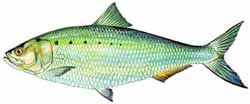 American
Shad; Common Name - Shad. American
Shad; Common Name - Shad.
Habitat - Anadromous; lives most of
its life at sea.
Spawning Habits - Most spawning
occurs between late December and early April
in the stretch of the St. Johns River from
Sanford to Melbourne. Eggs are spawned
directly into the river where they drift
freely for 2-3 days. Juveniles leave the
river when it cools in late fall or early
winter. Juveniles mature into adults in the
Atlantic Ocean and do not return to the St.
Johns River until they are ready to spawn,
two to five years later. In the St. Johns
River and all other rivers below Cape Fear,
North Carolina, shad die after they spawn.
Feeding Habits - Plankton feeders,
but strikes small bright spoons and flies.
Sporting Qualities - Historically the
sport fishery was mostly a troll boat
fishery with some spin casting from the
bank. In recent times, fly fishing has
become very extensive. Recreational fishing
began in the early 1940s near Deland. The
sport fishery is primarily located between
Sanford and Melbourne.
Eating Quality - Flesh good.
especially smoked; roe is excellent. |
| |
|
|